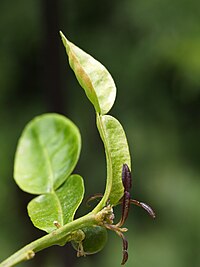Kaffir lime: Difference between revisions
m r2.7.1) (Robot: Adding fi:Ryppylimetti |
m mistake |
||
| Line 26: | Line 26: | ||
==Uses== |
==Uses== |
||
[[Image:Thai-keffir-galangal.jpg|thumb|200px|left|''Citrus hystrix'' Kabuyao(Cabuyao) fruit (left), used in Southeast Asian cooking, with [[galangal]] root.]] |
[[Image:Thai-keffir-galangal.jpg|thumb|200px|left|''Citrus hystrix'' Kabuyao(Cabuyao) fruit (left), used in Southeast Asian cooking, with [[galangal]] root.]] |
||
[[Image:Kaffir lime leaf.jpg|thumb|200px|left|Kaffir lime leaves are used in some South East Asian cuisines such as Indonesian, Lao, Cambodian, and |
[[Image:Kaffir lime leaf.jpg|thumb|200px|left|Kaffir lime leaves are used in some South East Asian cuisines such as Indonesian, Lao, Cambodian, and Thailand (มะกรูด).]] |
||
===Cuisine=== |
===Cuisine=== |
||
Revision as of 16:40, 21 August 2012
This article needs additional citations for verification. (December 2007) |
| Citrus × hystrix' | |
|---|---|

| |
| Citrus hystrix on sale | |
| Scientific classification | |
| Kingdom: | |
| (unranked): | |
| (unranked): | |
| (unranked): | |
| Order: | |
| Family: | |
| Genus: | |
| Species: | C. hystrix
|
| Binomial name | |
| Citrus × hystrix | |
| Synonyms | |
|
Citrus torosa Blanco | |
The kaffir lime (Citrus × hystrix, Rutaceae) is also known as combava, kieffer lime, limau purut,[2] jeruk purut or makrut lime, Kabuyao (Cabuyao).[1] It is a lime native to Indochinese and Malesian ecoregions in India, Laos, Indonesia, Malaysia and Thailand, and adjacent countries. It is used in Southeast Asian cuisine.
Description
Citrus × hystrix is a thorny bush with aromatic and distinctively shaped "double" leaves. The kaffir lime is a rough, bumpy green fruit. The green lime fruit is distinguished by its bumpy exterior and its small size (approx. 4 cm wide).
Uses


Cuisine
The rind of the kaffir lime is commonly used in Lao and Thai curry paste, adding an aromatic, astringent flavor.[3] The zest of the fruit is used in creole cuisine and to impart flavor to "arranged" rums in the Martinique, Réunion island and Madagascar.
The leaves can be used fresh or dried, and can be stored frozen. Its hourglass-shaped leaves (comprising the leaf blade plus a flattened, leaf-like leaf-stalk or petiole) are widely used in Thai[3] and Lao cuisine (for dishes such as tom yum), and Cambodian cuisine (for the base paste "Krueng"). The leaves are used in Indonesian cuisine (especiallyBalinese cuisine and Javanese cuisine), for foods such as sayur asam, and are used along with Indonesian bay leaf for chicken and fish. They are also found in Malaysian[4] and Burmese cuisines.
Medicinal
The juice and rinds are used in traditional Indonesian medicine; for this reason the fruit is referred to in Indonesia as jeruk obat ("medicine citrus"). The oil from the rind has strong insecticidal properties. The juice is generally regarded as too acidic to use in food preparation, but finds use as a cleanser for clothing and hair in Thailand.
Cultivation
Citrus x hystrix is grown worldwide in suitable climates as a garden shrub for home fruit production. It is well suited to container gardens and large garden pots on patios, terraces, and in conservatories.
Main constituents
The compound responsible for the characteristic aroma was identified as (–)-(S)-citronellal, which is contained in the leaf oil up to 80%; minor components are citronellol (10%), nerol and limonene.
From a stereochemical point of view, it is remarkable that kaffir lime leaves contain only (–)-(S)-citronellal, whereas the enantiomeric form (+)-(R)-citronellal is found in both lemon balm and (to a lesser degree) lemon grass, (note, however, that citronellal is only a trace component in the latter’s essential oil).
Kaffir lime fruit peel contains an essential oil comparable to lime fruit peel oil; main components are limonene and β-pinene.
See also
References
- ^ a b GRIN . accessed 5.5.2011
- ^ Limau Purut.
- ^ a b Loha-unchit, Kasma. "Kaffir Lime –Magrood". Retrieved 16 May 2012.
- ^ Pocket Guide to Asian Herbs & Spices By Wendy Hutton, Alberto Cassio
